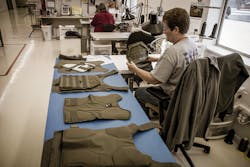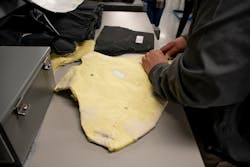In the consumer world it seems we can’t go a few weeks without reading about a new technology that will make our lives better, or at least more efficient. In law enforcement, it’s no different. There’s one place, however, where small, incremental changes happening over time have amounted to considerable improvements—body armor.
Reimagined materials
Over the last few years there have been a lot of changes in the body armor industry, especially in raw material development. The two most commonly used materials in body armor today are aramid fibers and ultra-high-molecular-weight polyethylene (UHMWPE), explains Matt Davis, president of Armor Express. “When it comes to aramid fibers, there have been advances in the fiber technology with finer denier yarns,” says Davis. “Finer deniers and higher yarn tenacity lead to lighter weight and better performance.”
On the UHMWPE side, there have been vast improvements across the board, too. “It used to be that Kevlar (aramid) was the only available fiber type. In recent years, however, more and more soft armor panels utilize UHMWPE, which has been commercialized by DSM, branded as Dyneema, and by Honeywell, as Spectra,” says Jake Ganor, CEO of Diamond Age Corp.
On a weight basis, UHMWPE is the strongest commercially available fiber. And companies keep making materials stronger. Ganor notes that DSM’s new “Force Multiplier” soft armor materials—SB115 and SB117—are 28 percent stronger than their old SB21 fiber. “This means that vests made using these new fibers are roughly 28 percent lighter than older models,” he says. “And they’re significantly more flexible as well. There are already armor panels made with this new material.”
With respect to hard armor, Ganor explains that there has been a lot of recent work in new ceramic materials, too. “The U.S. military is working on boron suboxide (B6O) which is as light as any ceramic in use right now, but which should exhibit superior performance,” he notes. “Diamond Age is working on a series of even lighter boron and silicon based ceramics. With these new materials, we should be able to reduce system weights by as much as 20 percent.”
Why does any of this matter for law enforcement? Weight and comfort. “These higher-strength polyethylene materials enable the manufacture of NIJ-certified soft body armor vests that are almost unthinkably light and thin. And these improvements in UHMWPE, alongside advances in armor ceramics, mean that hard armor plates are also on track to get lighter and thinner.”
Currently, the majority of law enforcement officers in the U.S. own steel body armor, says Joseph Taylor with Tactical Scorpion Gear. “The problem with steel core is that it is heavy and it fragments,” he says. “Let’s say you get shot and the bullet hits your steel plate...the shell is going to fall apart in pieces, and you could end up with shrapnel in your neck. It could actually be a worse hit than actually getting hit by the bullet. With the composites, the bullet actually goes inside and gets stuck.” The drawback? The cost per polyethylene plate can be significantly higher than steel, greatly affecting the already strapped budgets of many law enforcement agencies.
Despite these advances in body armor technologies, there’s the consideration that special threat rounds have been evolving, too. Body armor is only effective if it can stop modern threats, therefore, it makes sense to ask—Is body armor developing quickly enough to protect against new threats?
Protection from today’s ammunition
Using FBI statistics on fatal officer shootings, Ganor notes that the 9mm, .38 and .40 caliber rounds are by a wide margin the most common threats. “In fact, there have been more fatal officer shootings with those rounds than with all of the others combined,” he says. “The .45, the .22, 10mm, the .357 Sig, the .357 Magnum, and especially the .44 Magnum, hardly register.”
The most noteworthy new threats are a rather new series of high-penetration 9mm, .40 and .38 handgun rounds, says Ganor. “I speak of solid-copper projectiles optimized for hard-target penetration—the Lehigh Defense Xtreme Penetrator and Xtreme Defender rounds, and the Fort Scott Munitions Fort Defense solid copper spun rounds. The Fort Defense 80gr 9mm SCS round will easily penetrate most Level IIIa soft armor panels, and the Lehigh Xtreme rounds will often do the same. And these rounds are becoming increasingly popular. They’re not designated ‘armor piercing,’ and can be freely bought and sold just like lead-core ammunition. Although they’re still relatively uncommon, they are a potent emerging threat.”
Before purchasing body armor, each department should do its research to determine the types of threats its officers are most likely to face, as well as which ammunitions will pose the largest challenge.
Future of body armor
The changes in body armor are not limited to developments in material. With a change in raw materials comes a change in production techniques, too. “Newly-developed material production techniques, such as FAST/SPS and flash sintering, are opening up entirely new classes of materials, such as ceramic-nanomaterial composites,” says Ganor. “For just one example, ceramics reinforced with boron nitride nanotubes. It remains to be seen how these shall impact the industry, but they have very interesting potential.”
Next year, law enforcement can expect to see a complete change of the NIJ’s body armor standards, with a reported removal of the Level II – IV standards, says Armor Express’ Davis. “Over the last ten years we have gone from the NIJ 2005 interim requirements to the NIJ 0101.06 standard which was pretty significant,” he says. “Right now we are on the cusp of the NIJ 0101.07 standard.”
The major changes he expects to seeing are in nomenclature—HG I and HG II as well as RF I, II and III (HG for handgun and RF for rifle). Davis also anticipates seeing added rifle threats, standardized female testing protocol and increased velocities of conditioned armor testing. “This will be another major step forward for the standards and my expectation will be that armor will continue to be higher-performing.”
Body armor development is far from plateauing. It must be noted, however, that we’ve seen this before—companies coming out with a new body armor material and/or processes. For good reason, law enforcement is skeptical of many new products. Before purchasing any new body armor, agencies should not only look at the list of NIJ certified products, but also look at the standard to which those products were certified. Look at ballistic lab reports and test the products yourself if you can. With more research and development, body armor is projected to continue to become lighter and more comfortable, but ultimately it needs to stand up to the rigors of law enforcement.
A “Smart” Addition To Body Armor
Technological advancements are opening a new class of product which provides an extra layer of protection for LEOs beyond body armor. The Rio Grande City Police Department (Texas) became one of the first departments in the nation to test new Bluetooth-connected sensor panels worn underneath body armor. In the event of an officer getting shot or stabbed, says Rio Grande City Police Chief Noe Castillo, the Automatic Injury Detection System panels from Sprint allow immediate notification. “If something happens to an officer, all of us will get a message and it will ping the location with a map of where that officer is,” says Castillo. “A call will come to dispatch and open up the phone line to that officer, too. It will also give the location of where the officer was shot or stabbed, such as on their upper chest, lower chest, back, etc. With that technology, we can know where and when someone is injured.” Through an app on their phones, officers can also add additional information such as health considerations including blood pressure or current medications. If the officer ever gets injured, that information will be available to EMS. “You never know what’s going to happen from one moment to the next and in law enforcement there are officers getting hurt or killed it seems every other day,” says Castillo. “This is an extra layer of protection.”
A League Of Its Own
A combination of a material and a process, Duritium technology is in a league of its own. ShotStop Ballistics, the registered trademark and patent pending holder of Duritium, created the next gen polyethylene material to be lighter, thinner, more affordable and more dynamic, says Jason Henkel, operations manager at ShotStop Ballistics LLC. Henkel explains how this body armor is different. “Our Duritium has a strong tensile strength, combined with our utility patent, which is how we construct the layers of the polyethylene via a computer navigated layering system,” he says. “We have very specific angles of layering which allows kinetic energy to be dispersed about 20 percent more efficiently than industry-standard 90-degree layering. As a result, we are able to decrease the price by using less material while at same time utilizing our Duritium material, allowing us to make armor, insert plates for example, which are roughly 30 to 50 percent thinner and lighter…at the same protection levels.”
About the Author

Adrienne Zimmer
Editor
Adrienne Zimmer was the Editor of Law Enforcement Technology magazine, a monthly business-to-business publication that covers technology trends and best practices for public safety managers from 2017 to 2019. LET is part of Officer Media Group, which also publishes Law Enforcement Product News and Officer.com. Adrienne has been in publishing since 2013.

